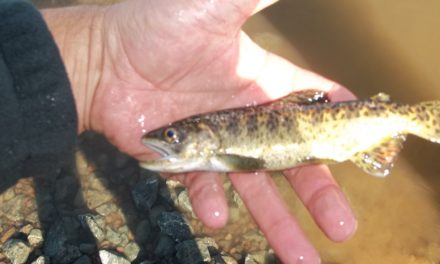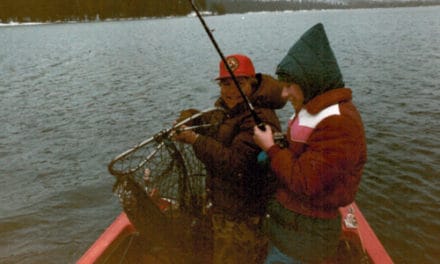Fishing Fun in Plumas County
By Bob Kopernik
Every once in a while someone will ask me where, in this area, they can take their 6 or 7-year-old grandson or granddaughter to catch fish? The easy answer is “Round Valley Reservoir just west of Greenville”. This impoundment is easily accessible and with a box of small red worms or meal worms and a bobber anyone can catch lots of sunfish almost any time of any day. If the kids tire of fishing or catching, the sandy beaches and shallow water offer lots of alternative ways to just have fun. All of our grandkids just loved going there. Now that they are a little older, they prefer fishing their favorite holes on Deer Creek which is easily accessible along Hwy 32.
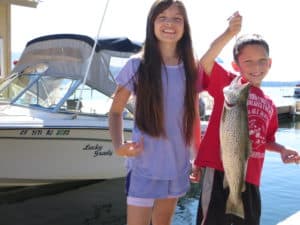
The three basic ways to catch fish here in Lake Almanor are to fish from shore, use a float tube or small skiff or fish from some type of motor boat. Each one of these provides opportunities and challenges, but if you put some thought and energy into your efforts you can be quite successful. Very impressive catches of Trout, Salmon, Bass and Catfish have been caught by using any one of these methods. There have been nearly 180,000 catchable fish planted in this lake every year for as long as I can remember. The California Fish and Wildlife mentions an 18 pound Rainbow Trout caught here and last year more big trout over five pounds were caught than anyone I know can remember.
If you are new or not familiar with this lake spend the ten dollars or so on a good lake-map that shows the bottom contours and water depths. When the lake is full, it offers over 44 square miles of prospective places to fish. Many successful fishermen believe that 10 percent of the available water will produce 90 percent of the fish that are caught. If you own a sonar unit sometimes (incorrectly) called a fish finder, you are in a better position, especially if you know how to interpret and make use of the information that it provides.
If I were going to fish from shore, I would fish all night and get my sleep during the day. If that isn’t your idea of having fun, I would suggest fishing an hour or two on both sides of sunrise and sunset. Try using a variety of natural baits with and without a bobber at various depths and try casting a variety of different style lures. Take a look at the shoreline. You might find where a winter runoff stream flowed into the lake. 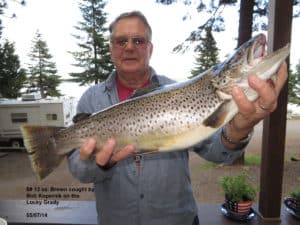 Fish both edges of the submerged creek bed and the deeper middle. Look at the map you bought and find where deep water is accessible within casting distance of shore. It might take some exploring but the effort to get there could actually be fun and probably very rewarding.
Fish both edges of the submerged creek bed and the deeper middle. Look at the map you bought and find where deep water is accessible within casting distance of shore. It might take some exploring but the effort to get there could actually be fun and probably very rewarding.
If you saw my article in last year’s summer edition of Mountain Valley Living Magazine (it wasn’t mentioned) but the main photo showed only five of the nine fish caught one morning from float tubes. Granted this was probably one of the more productive days for these two good friends of mine, but it illustrates what is possible if you put in a lot of hours and try to figure out what produces fish and what does not. Small skiffs and kayaks allow you to fish a variety of accessible locations all around the lake and I have even seen sonar units and small down riggers mounted on kayaks. It is amazing how creative we fishermen can get.
The ability to troll with a motor allows you to cover more territory with less physical effort. But don’t get the idea that because the motor is doing the physical work that you will automatically catch more fish. You really need to study your map and identify the 10% of the water that produces most of the fish. Before this lake existed, much of the land (now lake-bottom) was used for dairy farming. There were lots of natural 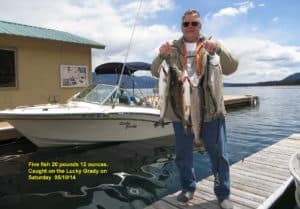 springs, expansive meadows and rolling hills, land formations that created peninsulas, rock piles and river and creek bottoms. They all provide potential structure and or cover that can hold fish. After fishing this lake for over 35 years I have 15 or 20 areas that I fish more frequently. Each of these areas is unique as to depth and structure and sometimes the fish are there and sometimes they are not.
springs, expansive meadows and rolling hills, land formations that created peninsulas, rock piles and river and creek bottoms. They all provide potential structure and or cover that can hold fish. After fishing this lake for over 35 years I have 15 or 20 areas that I fish more frequently. Each of these areas is unique as to depth and structure and sometimes the fish are there and sometimes they are not.
In general, I seem to catch more quality fish in areas where the lake bottom slopes up from 35 to maybe 15 feet deep. Another favorite is a sharp drop off and I like to free fall my down rigger ball 15 to 30 feet paying particular attention to any hits as the bait or lure is dropping. When trolling night crawlers if a fish hits the bait, but doesn’t get hooked; I quickly pay out 15 or 20 feet of line and if the bait gets hit again, it almost always produces a solid hook up.
One thing for sure, trout and especially salmon move in and out of particular areas. Sometimes I can catch trout in an area all summer and the next year it seems like they didn’t come back. Salmon on the other hand, seem to be constantly on the prowl. Salmon do frequent some areas with some consistency, but not always. Last year was an anomaly. Due to the lack of a snowpack in our watershed the whole lake was unusually warm. This caused prolific hatches of insects and pond smelt. I believe the fish had so much natural food that they were not very interested in the baits we fishermen were offering. The good news was  the fish we did catch on average were exceptionally large. I think the 2015 fishing season will also produce some very impressive catches.
the fish we did catch on average were exceptionally large. I think the 2015 fishing season will also produce some very impressive catches.
One last suggestion that I offer, if you are discouraged by not catching very many quality fish or just want to gain a wealth of knowledge about fishing this wonderful but sometimes frustrating body of water, consider hiring a fishing guide. The website of another great local publication, “The Almanor Fisherman” lists a number of guides offering a variety of options. Some have patio boats for large parties and are well suited for youngsters who do better still fishing. Others offer fly fishing or bass fishing and others offer trips that include both still fishing and trolling. Note that I (normally) specialize only in trolling for trout and salmon.
I and at least one other guide, offer a “Learn the Lake” outing that actually takes you to and explains where and how to fish at five or six different areas of the lake. I spend significant time on how to use a sonar unit, rods, reels, basic knots for tying leaders, lures and how to rig baits. I’m surprised how often clients need help in how to properly set the hook, play a big fish and coax it into the net.
Be sure to clearly communicate with the guide that you choose what your needs, desires and expectations are, being aware that even the most experienced fishing guides can’t guarantee that you will catch fish. (That’s really why we call this sport “Fishing” instead of “Catching”.) To see the guides listed go to…
http://www.almanorfishingassociation.com/lake_guides.html
Good luck, have fun and “THINK BIG FISH”.
Bob Kopernik
Lucky Grady Fishing Guide Service
LuckyGrady1@att.net




